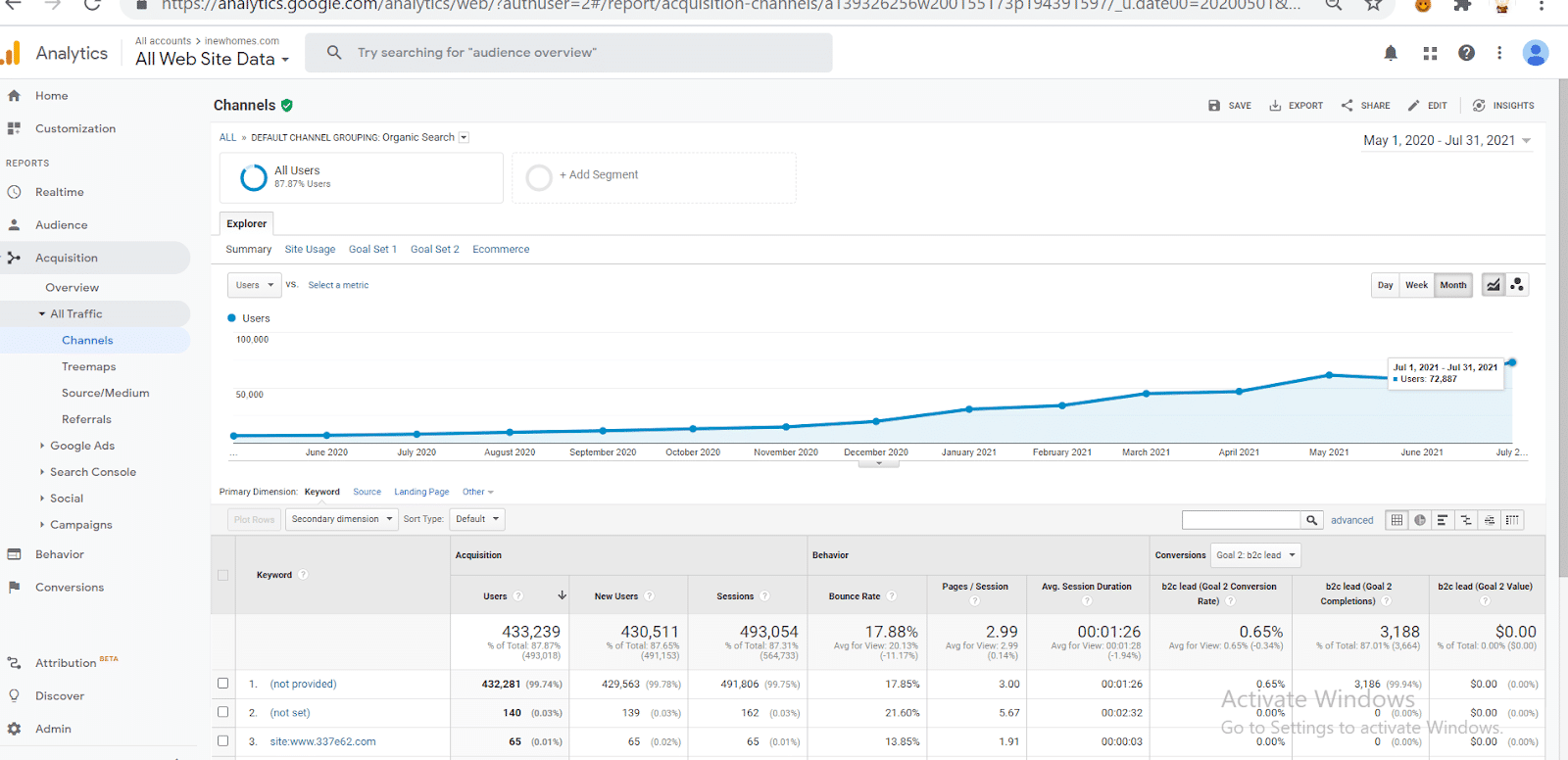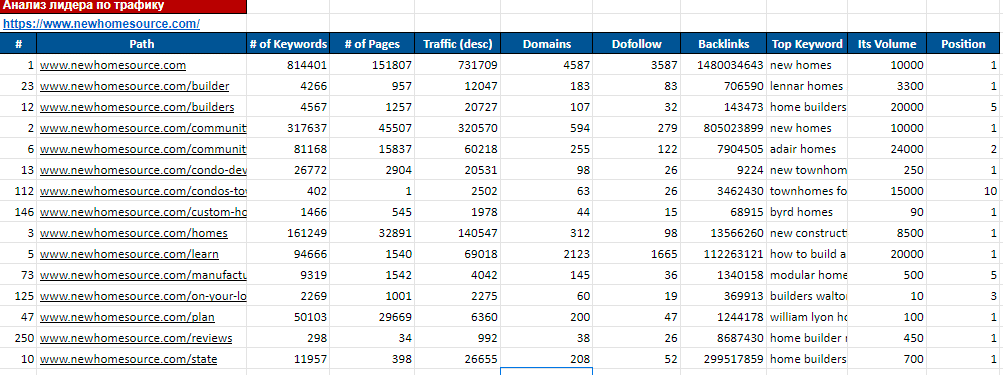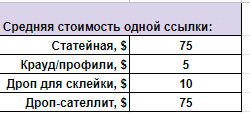Promoting a startup is not an easy task. Especially when it comes to Real Estate in the United States. The problem is that there is enormous competition: TOP players have been promoting themselves for years, so now they occupy the first few pages in search results. It would seem that getting there is unrealistic. Nevertheless…
With a competent approach and some features, Luxeo Team managed to get 100 thousand traffic from scratch and surpass major players. And all this was made in 6 months and with a limited budget for links and promotion. In this case, we will analyze what we have performed to achieve this result.
iNewHomes is a marketplace for the sale, purchase, and rental of real estate in North America. The portal database contains more than 30,000 objects.
Industry
Real Estate
Target region
USA (focus on Miami)
Goals
Increased traffic Receiving applications through the website
Service
Period
June 2020 — December 2020
Result
Growth of organic traffic by 304%, 550 keywords in TOP 10
The resource is focused on:
The iNewHomes owner is a realtor living in the United States for many years. The client contacted us in May 2020 with a request to increase traffic from zero point.
Deeply understanding the specifics of the market, the client understood that it was difficult to become a leader there, so he did not believe in marketing tools without millions of investments.
Also, serious obstacles for any young website in this area are the lack of trust from the audience and problems with the customer balance. It was necessary to attract both landlords/sellers of objects and tenants/buyers simultaneously.
Furthermore, the client had a lot of mistrust, as he had a negative experience working with another SEO studio: traffic grew very slowly, and the customer received very few applications. In June, there was a surge in traffic, but it arose after cheating. Of course, it did not help the situation and affected it negatively. So, in July, the client decided to contact us.
Quantitative metrics before promotion:

The client identified 3 key goals to achieve:
The real estate industry is one of the most competitive in the United States, and it was the factor that determined the main challenges of promotion:
The stumbling block at the first stage was that the client did not expect decent results from SEO. It set the critical task for us: to demonstrate the promotion efficiency. And we had to start with analyzing and developing an MVP strategy.
Audit: what internal problems did we detect
At the initial stage, our team started analyzing the resource to determine its weaknesses and risk zones. Here are some of the problems we’ve identified:
MVP development: how we assessed the potential of the project
After the analysis, we started developing MVP, a test version of SEO. This is a crucial step necessary when working with a startup in a highly competitive niche. The purpose is to test promotion hypotheses before significant financial investments and to show the client the dynamics of traffic growth over several months.
In the first month, after completing the initial steps, an increase was recorded from 9 thousand to 15 thousand, which proved the effectiveness of our hypotheses and the general effectiveness of SEO for this resource. The client decided to continue promoting and began to implement our recommendations actively.
Project management: how we organized the work
We gathered a team of 3 performers: team lead, SEO specialist, and link builder. The team was led by a project manager responsible for tracking progress and communication.
We organized teamwork according to the Agile model, dividing the process into sprints. The client got access to all intermediate results and could provide us with feedback to adjust the strategy after each iteration.
Our first step was analyzing the US real estate market to identify direct and potential competitors. Having studied the search results for relevant queries, we formed the TOP 10 competitors, among which there were both developers and aggregators.
Comparison by reference parameters of the main competitors

As a result of the comparison of indicators, we distinguished 3 companies that required a more detailed analysis:



Also, we provided a global analysis of additional page types, studied the frequency, competitor traffic, and the number of links, and set priorities for the promotion and development of the project.
Having received an objective understanding of the competitive environment, we proceeded to develop a strategy for the year.
Our priority was:
Forming a semantic core and collecting keywords is one of the highest priority steps in launching an SEO campaign for any website. We often start this stage with an in-depth analysis of the market, demand, and competitors. It gives us a solid understanding of the project work plan and the possibility to predict the potential for traffic and applications in the long term.
Ideally, the website should collect traffic for relevant queries, such as “rent new flats in Miami” or “buy new homes in New York,” across all states, cities, and regions of the United States. It is helpful for a business because a real estate aggregator is monetized by reselling leads to other realtors or specific properties.
But after analyzing the demand and the market situation, we found a lot of new opportunities for obtaining additional traffic, which is also valuable.
We have collected a common semantic core for articles and requests for priority cities and agglomerations.
General SC (example):
Based on the analysis of additional types of competitors’ pages, we selected the most relevant queries, for which it was necessary to add the ability to create new kinds of “filtering” pages:
The following query groups were also included in the SC:
We found many new low-competitive requests allowing us to receive new traffic in a few weeks creating pages for them. Also, by creating pages for narrowly targeted keywords, we increased the conversion rate since the user saw the most targeted content for their request.
Our task was to improve the resource following the technical requirements that arose after developing a new website structure.
Since many new pages, categories, and filters were planned, it was necessary to automate this process as much as possible so that the client would devote a minimum of effort to support all implementations, but it would work properly.
It required creating technical specifications from scratch to fill every gap.
How we created technical specifications for meta tags, friendly URLs, and new types of pages:
For the automatic generation of meta tags on the pages of complexes and zip-codes, we have developed TDH templates (Title, Description, H1) following the requirements of search engines and the preferences of the target audience.
TDH template for complexes
Example for a complex: https://inew-homes.com/hallandale-oasis-complex
TDH template for zip-codes pages
For main pages with “new homes”
For main pages with “homes (/sold)”
For main pages with “rent (/rent)”
When filtering was applied, the content on the search page was created using get parameters + these pages were closed from indexing. Due to this, Google could not detect the content and did not rank it by relevant keywords.
We solved the problem by adjusting the formation of friendly URLs for filtering pages so that when a filter was selected, a unique page with relevant content opened. It made the UI much more convenient.
The competitor we were targeting:
https://www.zillow.com/houston-tx/swimming-pool_att/
TDH templates for filtering pages by property type:
TDH templates for filtering pages by the number of bedrooms:
TDH templates for filtering pages by the number of bedrooms and house type:
Other types of filtering (Price, Square feet range) were implemented using get parameters with rel =”canonical” setting to the main static URL.
It was necessary to add the ability to create new types of “filtering” pages for 3 types of requests: zip code; neighborhoods (city districts); price range (under $200k).
We implemented the functionality of splitting by zip codes and linking to this real estate.
Meta tag templates
The competitors we were targeting:
https://www.redfin.com/zipcode/33126
https://www.har.com/zipcode_77494/realestate/new_construction
https://www.newhomesource.com/communities/tx/houston-area/77494
We implemented the functionality of dividing cities into districts with reference to these real estate districts.
Meta tag templates
Competitors:
https://www.redfin.com/neighborhood/548734/TX/Houston/Montrose
https://www.zillow.com/montrose-houston-tx/
https://www.realtor.com/realestateandhomes-search/Neartown—Montrose_Houston_TX
On the search pages (“/search”), there was a filter for setting a price range for filtering. But when implementing unique URLs and meta tags for filter parameters, we got a problem: when the range was changed even by $1, another page was generated. It caused complexities with page count, indexing, and ranking.
To avoid unnecessary filtering pages by price range, we decided to create static pages for a certain number of search queries by price (100k-500k for sale, 500-5k for rent).
Meta Tag Templates:
Competitors:
https://www.masonluxuryhomes.com/i/houston-tx-homes-sale-150000-200000
https://www.newhomesdirectory.com/Houston/100k
https://www.harrietmartin.com/homes-for-sale-in-miami-fl-200000-to-300000
One of the problems of promoting a large aggregator is the need for a large amount of content on category pages + blog + FAQ. So we got new tasks: to finalize the blog, configure the content generation algorithm for new category pages, and develop a new content plan.
Usually, in our practice, we not only help to create a content plan but also provide recommendations to improve the user experience on the website. Often we have situations when the client does not hire a marketer to do this, or the client’s marketing team is busy, so we help implement our plans quickly.
In this project, we helped the customer because he did not have a marketer.
We designed the structure of article pages for a blog and separate blog categories, providing technical recommendations for H1-H3 headings, alt/title attributes, micro-markup, and Title-Description-H1 meta.
An example of technical specification for the article page structure
TDH Template example
To get unique texts for 57 thousand and FAQ for 150 thousand pages, we implemented spinning (including /sold and /rent, Complex and Zip codes), a content generation algorithm.
Text spinning is used to automate the content creation process.
Interchangeable words have been included in the spinizers. Randomization made the text unique, generating sentences organically. We also used variables, pulling up the values depending on the state.
Sample text for a company
We significantly expanded the structure of the website with new commercial pages. In addition, our team developed a content strategy for the blog of the iNewHomes resource.
Expanding the structure and comprehensive work with the content helps to create a lot of entry points to the website using targeted requests, which ultimately affects both traffic and website conversion.
When analyzing competitors and demand, we found both highly competitive and low-competitive queries with a high frequency. Therefore, understanding the need for increased traffic in a short time, our specialists chose clusters of key queries with the greatest potential and less competitiveness:
An example of analyzing and collecting SC for articles:
According to these groups, we developed detailed terms of reference for copywriters for each article.
TC Example for new texts
We started working on the LB strategy by analyzing the number of links per month and year by the crowd as well as profiles and articles of competitors, considering their monthly cost. Then we calculated the average cost of one link.

It allowed us to draw up a clear link plan for the main pages, including those focused on competitors.
Based on the global SEO strategy built in the first stage and the link analysis, we predicted what maximum (minimum) and average traffic indicators could be expected in the future.
Due to the limited budget for links, the first thing we did was to agree with the platforms on content placement (outreach), and the second was to start looking for drop domains.
Drop domains are websites that have expired. Typically, SEO strategies use such websites to generate valuable links at an optimal cost compared to “live websites”. It is especially relevant with new resources that need rapid growth. If you find a good drop domain for a business-relevant topic and redirect to your website, you get backlinks, trust, authority, and age from the drop. In this way, we simulate moving a well-ranked domain to the current one.
We found relevant drops for gluing with the main domain, selected content-relevant pages, and set up redirects. We used links from the received satellites and entered data for each URL to measure performance indicators.
Further, our team completed all the tasks of compiling anchors and technical specifications for articles, posting content on websites, forums, profiles, and get-posting. We were responsible for communication with webmasters and copywriters throughout the entire promotion period.
Immediately after eliminating technical errors, an organic jump from 9 thousand to 14 thousand was detected, almost 50%! And this is only due to implementing our requirements.
The TOP contains 550 keys, including high-frequency ones.
In just 6 months, traffic grew by 304%.
In general, an increase of up to 100 thousand was noted over the year!
Quantitative metrics after promotion:
We performed global technical transformations, eliminated severe problems from incorrect website structure to bad rendering. The secret of our success in optimization is thorough work with the content, the spinning of templates, the correct selection of drops, and the placement of links to increase awareness. Acting according to the plan, we got what the client was waiting for and even more.
CONTACTS
Promotion application: [email protected]
For partnership: [email protected]
Thanks for your application!
Our specialists will contact you within 24 hours